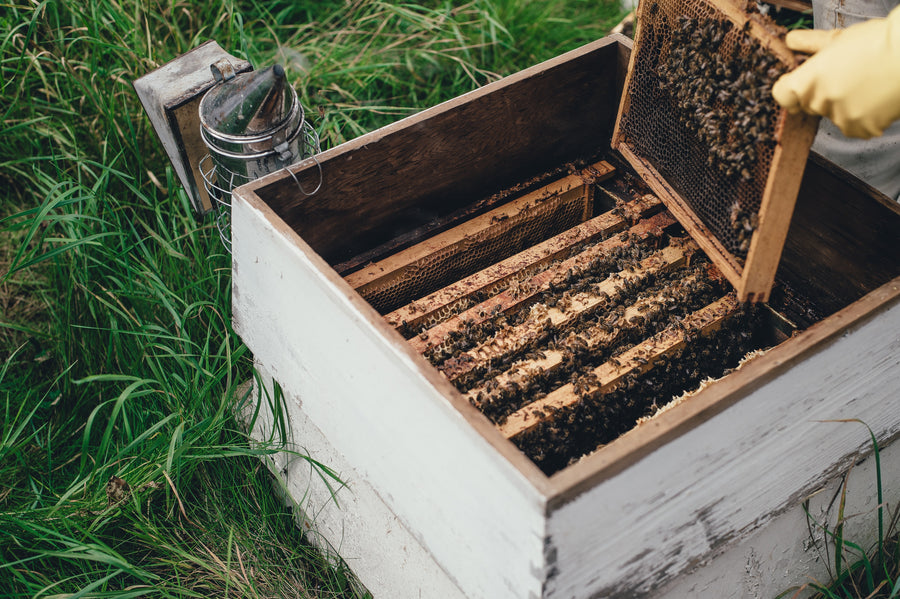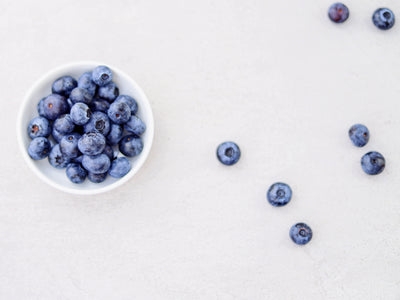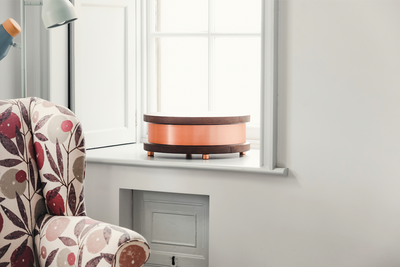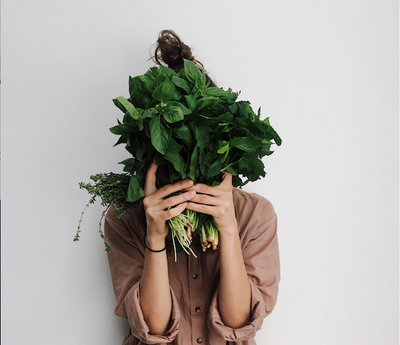The healing powers of bees…and how to support them at home

Thought all prehistoric life died out with the dinosaurs? Think again. Bees first appeared on Earth 130 million years ago and have been on an incredible journey of evolution ever since. Today, 20,000 species of these velvet invertebrates buzz about our planet.
Writing in his journal, 18th century beekeeping pioneer, Anton Jansa, noted that “amongst all God’s beings, there are none so hardworking and useful to man with so little attention needed for its keep as the bee."
Bees play a critical role in the complex ecosystems that sustain life as we know it, helping to pollinate around 90% of all food crops. Whether pollinating our fruits and vegetables or the food for the animals we then consume, the average meal (plus the coffee and chocolate that might follow) owes a great deal to the industrious bee. Without them, our wellbeing would be precarious and our diets poor.
And yet, bees now find themselves under dire threat from habitat loss, pesticides, climate change, electromagnetic radiation and disease.
"Bees play a critical role in the complex ecosystems that sustain life as we know it, helping to pollinate around 90% of all food crops."
Why are bees in decline?
According to the first global scientific review of its kind, the world’s insects – bees included – are hurtling down the path to extinction, falling by a precipitous 2.5% a year with environmental repercussions that will be “catastrophic”.
The scientist behind the review, Francisco Sánchez-Bayo, told the Guardian that “the main cause of the decline is agricultural intensification. That means the elimination of all trees and shrubs that normally surround the fields, so there are plain, bare fields that are treated with synthetic fertilisers and pesticides.”[1]
Earlier this year, an analysis of 90 studies revealed that toxic farming pesticides are killing bees at an alarming rate.[2] Further research[3] shows that, when you combine pesticides with electromagnetic frequencies (EMFs) from phone masts and wireless technology, you see “higher mortality, behavioural alterations and biochemical anomalies” in bee colonies.

The bee-human bond
Thanks to the many precious things bees produce – from liquid gold honey to multi-purpose beeswax – the human-bee connection goes back thousands of years.[4] Ancient Greeks thought of bees as a symbol of immortality, and ancient Egyptians worshipped them, while Australian Aboriginals have used beeswax to make rock art for at least 4,000 years. In 19th century New England, ‘telling the bees’ was a popular tradition, with people informing their hives of births, deaths and marriages. Bees are also a recurring feature in religious scriptures, mythology, cosmology and iconography.
"Beekeeping is a time-honoured activity, reaching back to Mayan Mexico and the temples of ancient Egypt."
Do beekeepers really live longer?
Beekeeping is a time-honoured activity, reaching back to Mayan Mexico and the temples of ancient Egypt. Far from just hearsay, the belief that beekeepers live longer is supported by science. A study into the relationship between telomere length (telomere length is a marker of biological aging) and beekeeping among Malaysians found that “beekeepers may have longer life compared to non-beekeepers”, and, that “the consumption of bee products” was associated with an “increase in telomere length” – AKA longevity.[5]

The medicinal properties of honey
It’s thought that the ability of humans to climb trees mainly stems from their overwhelming desire to collect honey. One taste of the deliciously floral and sweet golden syrup, and this theory seems plausible. But honey isn’t only prized for its flavour; it has been used for medicinal purposes for thousands of years thanks to its antioxidant, antimicrobial, anti-inflammatory and even anti-cancer properties. Ultra-rich in nutrients, studies show[6] honey can:
- Heal wounds
- Ease coughs and colds
- Soothe a sore throat
- Reduce Asthma and other allergies
- Be a beneficial aid in the treatment of diabetes
- Improve gut health
- Moisturise skin
- Help relieve ulcers
- Exert anti-cancer effects
- Help with cardiovascular health
- Provide a natural energy boost
In a recent study, researchers found that honey may even be more effective at treating coughs and colds than many over-the-counter medicines.[7]
"Local honey is so much more than something sweet for the breakfast table. I love the idea that it captures a flavour of the field or the woodlands; it becomes a little pot of natural history.”
To get maximum benefit, we recommend eating raw, unpasteurised, preferably local honey, to make sure the active ingredients are still intact. South Downs beekeeper Lia Markwick is also a fan of keeping her honey local, telling Toast Magazine: “I feel very passionately about local honey. It's so much more than something sweet for the breakfast table. I love the idea that it captures a flavour of the field or the woodlands; it becomes a little pot of natural history.”

In the quieter winter months, there’s nothing nicer than lighting a natural beeswax candle and watching it cast a warm glow. Lia loves the process of gathering beeswax, too: “We treasure all the beeswax that we get,” she says. “I've heard it referred to as a waste material, which baffles me, because I think it really should be treasured. The bees work so hard on it, and it takes such a long time to produce a tiny amount.”
In wintertime, she’ll warm up the gathered wax throughout the day, then hand-dip candles in the evening. “It's quite meditative. I like the uniqueness of each batch, because there are natural variations in shapes and sizes ‒ sometimes I lose count of how many dips I've done! I like that it preserves some of the season, taking something from the hive in the summer and then carrying it through to winter.”
Read more about the anti-allergy benefits of honey here.
Read more about how propolis (another bee product) can help protect against the effects of EMF exposure here.
Read more about the gut-healing properties of honey here.

What about non-honey bees?
Now we’re familiar with the habits of the honey bee, what about the rest of their furry winged friends? While bumblebees live in colonies, the large majority of wild bees lead solitary lives – and are the unsung heroes of pollination. In Britain, we have around 270 species of bee, and just under 250 of them are solitary bees.[8]
"The red-tailed mason bee makes its nest in empty snail shells, using chewed-up leaves to seal the entrance."
From the Mason Bee to the Miner Bee, the Leafcutter Bee to the Hairy-Footed Flower Bee, solitary bees vary in shade and size – whether bulbous and jet black, metallic blue or easily mistaken for a wasp.[9] Their nesting behaviours are just as diverse (and fascinatingly complex) too. As their name suggests, Leafcutter Bees carefully slice off pieces of leaf or petal, which they then use to build their dwellings. Another aptly named species, the Carpenter Bee, burrows into soft wood. The Red-Tailed Mason Bee makes its nest in empty snail shells, using chewed-up leaves to seal the entrance. But most solitary bees nest in the ground, using their bodies to dig out a series of tiny chambers. The female adds pollen to each hole, often moistened with nectar, and lays an egg.[10]
Some species also nest above ground, making use of holes left by previous inhabitants (like beetles), which they then seal with mud, resin, pieces of petals or leaves. According to expert ecologist Ryan Clark, “these species are the ones most likely to take to artificial nests in gardens.”

Open your own bee hotel
Sold in the Conscious Spaces shop, bee houses are an ingenious way to help support solitary wild bees and boost biodiversity in your backyard. Crafted by fellow Cornish business (and certified B Corp), Green&Blue, our range spans from mini beepot planters to larger bee blocks. By putting a bee house in your garden, allotment or even balcony, you’re providing a nesting place for solitary bees so they can continue their vital pollination work.
Each bee block contains smooth cavities (to avoid damaging delicate wings) in which solitary bees can lay their eggs. The bees then seal the entrance with chewed vegetation or mud, before their offspring emerge the following spring. This cycle will be repeated year after year.

“Solitary bees are fascinating to watch and safe to encourage around children and pets as they are non-aggressive,” says Green&Blue. “They have no honey or queen to protect meaning they have nothing to defend.”
Green&Blue’s award-winning bee bricks can even be used in place of a standard brick in construction, and built into the walls of your extension, landscape project, new build or retrofit to provide additional habitat for solitary bees.
"By putting a bee house in your garden, allotment or even balcony, you’re providing a nesting place for solitary bees so they can continue their vital pollination work."
It’s important to position your bee block in a warm, sunny spot with no vegetation obscuring the entrance – ideally placed at least 1 metre up from the ground. Et voila – your bee hotel is now ready to receive guests.
Not only do they look great, but bee houses are an easy way to do something about our declining bee population, alongside bee-friendly planting and other wildlife-friendly measures.
Learn more about what a wildlife and bee-friendly garden should include in our article, ‘How to Rewild Your Garden’.

References
[1] https://www.theguardian.com/environment/2019/feb/10/plummeting-insect-numbers-threaten-collapse-of-nature
[2] https://www.bbc.co.uk/news/science-environment-58089545
[3] https://ehtrust.org/new-study-pesticides-together-with-electromagnetic-fields-can-stress-bees-leading-to-colony-collapse-disorder/
[4] https://link.springer.com/article/10.1007/s13280-020-01333-9
[5] https://www.ncbi.nlm.nih.gov/pmc/articles/PMC4450150/
[6] https://www.ncbi.nlm.nih.gov/pmc/articles/PMC5424551/
[7] https://ebm.bmj.com/content/26/2/57
[8] https://www.wildlifetrusts.org/blog/ryan-clark/guide-solitary-bees-britain
[9] https://www.buzzaboutbees.net/solitary-bees.html
[10] https://www.wildlifetrusts.org/blog/ryan-clark/guide-solitary-bees-britain























